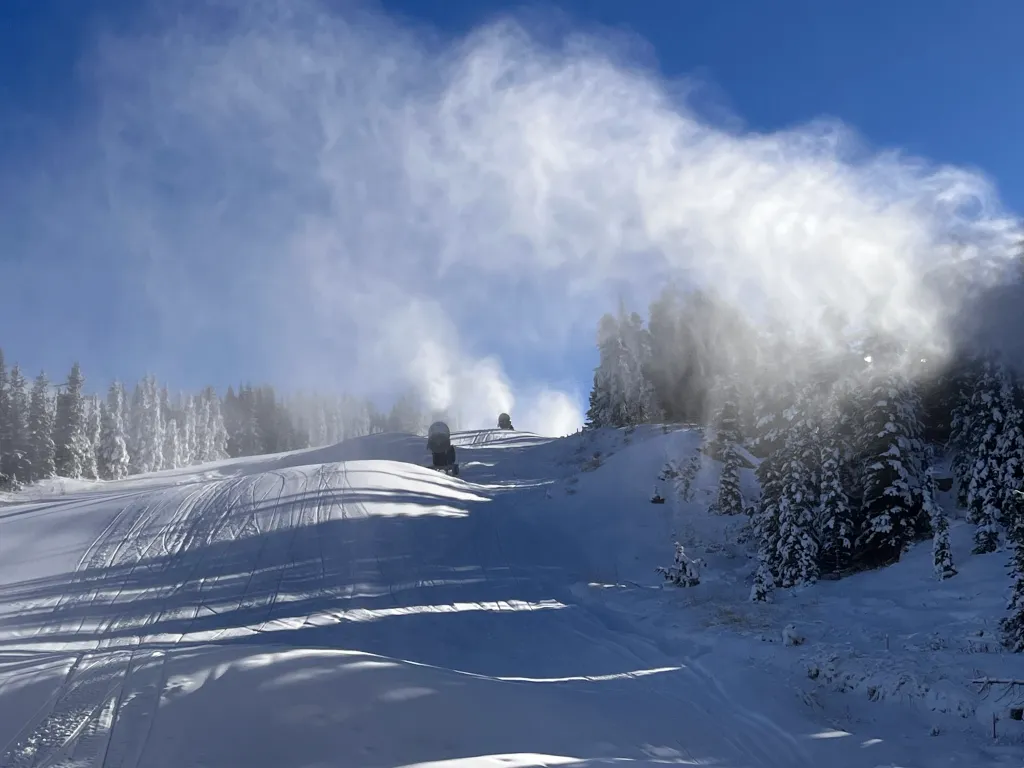This story was originally published by Montana Free Press at montanafreepress.org.
The Yellowstone Club, the elite resort near Big Sky that in the past has counted Bill Gates, Justin Timberlake and Jessica Biel as members, has become the first ski area in Montana to turn wastewater into snow. And while skiing on what was once sewage might seem odd at first blush, resort officials and local conservation groups said it’s both safe and beneficial to the environment, especially during dry winters like this one, which has left some ski areas in the state shuttered.
In fact, Richard Chandler, vice president of environmental operations for the Yellowstone Club, said recently that the new program to turn wastewater into snow is helping the resort open more runs than it otherwise might be able to this winter.
“Without [snowmaking], we’d be skiing on a lot less terrain,” Chandler said.
The new effort to use recycled water to increase the base layer of snow on Eglise Mountain follows a decade of collaboration between the resort and local environmental groups, plus a multi-year review by state regulators. It isn’t the first time the Yellowstone Club has found a new use for wastewater: For several years, it has been using recycled water to irrigate its golf course.

In 2011, the Gallatin River Task Force, Yellowstone Club and DEQ studied whether wastewater could be used to make artificial snow to ski on. The idea was that as climate change made the region’s snowpack more unpredictable, they could serve skiers and the watershed by making snow from treated water that is traditionally just put into rivers and other bodies of water. That winter they successfully turned a half-million gallons of wastewater into two acres of snow about 18 inches deep.
According to the Yellowstone Club, 12 ski areas in eight states, plus some in Canada, Switzerland and Australia, have used wastewater to make snow in the past. However, the practice hasn’t been without controversy. About a decade ago, a ski area near Flagstaff, Arizona, was sued by a local tribe over environmental concerns about turning wastewater into snow. The Hopi Tribe also alleged that the practice would desecrate a mountain it considered sacred. The tribe eventually lost in court, but during the dispute some environmental groups, including the Center for Biological Diversity, raised concerns about the impact the recycled snow might have on aquatic life in the area.
But Chandler said that using recycled water to make snow treats the wastewater even more than it normally would be before being released into a river. By shooting it through the snowmaking equipment (it’s essentially misted onto the slopes as snow) the wastewater is treated again. Then, as it melts in the spring and enters the ground, it’s filtered a third time. Chandler also said that the compacted snow on the slopes will last longer into spring and summer, adding water to the aquifer at a critical time and helping streamflows later in the season. Because of that, groups like the Gallatin River Task Force, Trout Unlimited, American Rivers, Great Yellowstone Coalition and the Association of Gallatin Agricultural Irrigators all came out in favor of the project. Chandler estimates that the man-made snow will increase summer runoff in area creeks by about 19 days.
Crushed by negative news?
Sign up for the Reasons to be Cheerful newsletter.“The benefits of this project are actually an enhancement to the watershed function,” said Pat Byorth, Montana water director for Trout Unlimited, in a press release. “It’s an enhancement to water supply, to water quality in the basin. So everybody from skiers to anglers will benefit from this, and downstream agriculture benefits at a time where water supply is uncertain.”
In 2020, the Yellowstone Club applied for a permit from DEQ to expand that 2011 pilot program into a permanent snowmaking operation on Eglise Mountain. The following year, the state issued a permit allowing the Yellowstone Club to turn 25 million gallons of wastewater into snow annually. Two years and $12 million later, the new system began making snow last November. Under the current plan, 80 percent of the recycled water is coming from the community of Big Sky and 20 percent is coming from the Yellowstone Club. As part of its permit, the Yellowstone Club is required to erect signage warning visitors not to consume the snow.
As winters get drier in the American West, Chandler said that turning wastewater into snow could be the key for ski areas across the region in the future. He said he hopes the club can set an example.
“We hope that we can show other ski areas in the state what is possible,” he said. “We might be the first, but I hope we aren’t the last.”






